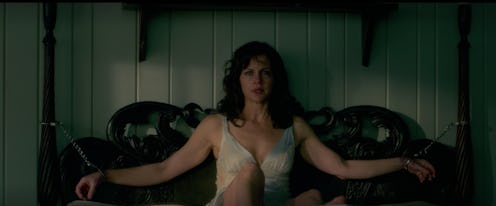Entertainment
Why Netflix's New Thriller 'Gerald's Game' Feels So Creepily Real
When Netflix announced they were adapting Stephen King's 1992 book Gerald's Game into a movie, it seemed an odd choice out of the author's vast body of work. Aside from the fact it's not one of King's more beloved books, it seems the least adaptable to film, at least on the surface, as it revolves around a woman trapped handcuffed to a bed after her husband dies during one of his sexual games. One person, one room, and a lot of internal thoughts. The story is so deeply personal, many were perplexed it came from a guy who usually sticks to straightforward monsters. So, was Gerald's Game based on a true story King actually knew?
In a 1992 Fresh Air interview, the author explained that his inspiration for the story started with Cujo, his bestselling book about a violent, rabid dog trapping a woman and her sick son in a car. Two people, trapped in a small place. As King explained in the interview, he thought, wouldn't it be interesting if you had only one character in a room? But why would this woman be in a room by herself? As King revealed to Fresh Air, "the answer that I came up with was bondage. And that forced me to consider what causes people to do this sort of thing." Researching bondage, he worked backwards from there to figure out how the rest of the woman, now named Jessie's, story went down.
Authors never work in a vacuum, and the story's strong emphasis on freeing oneself from "victim culture" was likely inspired by reality as well. The False Memory Syndrome Foundation is a non-profit dedicated to studying False Memory Syndrome, providing advocacy for those accused of child sexual abuse based on FMS. FMSF was founded in 1992 by Pamela and Peter Freyd, after their adult daughter Professor Jennifer Freyd claimed she'd suddenly uncovered memories of childhood abuse after years of therapy. The debate over how memory works, and whether memories can be utterly repressed and recovered, raged in the media for months, and it's probably not coincidence that Gerald's Game's Jessie, a year after the FMS' founding, struggles with the very same issues.
One of the film and story's creepiest elements is the "space cowboy" of the book and "Moonlight Man" of the movie, a terrifying figure lurking on Jessie's periphery that comes to embody Death in her mind. The viewer, and Jesse, aren't sure if he's just a hallucination, but it turns out (shudder) that he's definitely based on a true story. Just as the Moonlight Man has a bag of bones and trophies, serial killer Ed Gein really did exhume corpses from his nearby graveyard and festoon his house with their bones and skin. There's an exhaustive list of what they found in his house, but let's just say one of the less disturbing items was human skulls on his bedposts. Yep. Gein also inspired Psycho, Silence of the Lambs, and The Texas Chainsaw Massacre, which gives a pretty solid idea of Jessie's state of mind seeing this guy in the corner of a room.
On a less disturbing note, King wrote his books Gerald's Game and Dolores Claiborne to interrelate with each other. Both are less outright horror and more the horror of man's inhumanity to man, and both feature terrible life-changing events during a total solar eclipse in 1963. The solar eclipse was very real — Maine was right in the path of totality at the time, and the event seems to have deeply impressed itself on King to spur not one but two novels' most traumatic moments.
An author's talent is taking disparate elements from reality and piecing them together into something more than the sum of its parts. With Gerald's Game available to watch, you can see for yourself whether truth is stranger than fiction.
